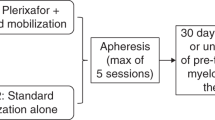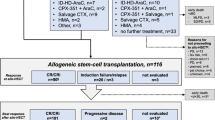Abstract
The objective of this study was to assess the efficacy of an injection of 100 μg/kg of pegfilgrastim in haematopoietic recovery and mobilization in children following 32 courses of chemotherapy. End points were duration of neutropaenia, myeloid recovery and PBMC collection. Neutropaenia lasted a mean of 4.7 days (±2.13 days). Myeloid recovery occurred at a median of 10 days (inter quartile range (IQR) 8–11). Febrile neutropaenia complicated 13 courses (40.6%). Mobilization was observed in 20 out of 26 assessable courses (76.9%). The rise in CD34+ cells occurred at a median of 6 days (IQR 4–7) after PEG and remained >20 per μl for 6 days (IQR 4–8), with a median value of 80 per μl (IQR 48–170.5). The median CD34+ cell peak was 165 per μl (IQR 82.5–331), 9 days (range 6–14) after PEG. PBMC were collected on average at day +5 (+4 to +9) after PEG. In 93.3% of collections, at least 3 × 106 per kg CD34+ cells were collected through a single apheresis. Myeloid recovery occurred in all cases within 15 days, without concomitant thrombocytopaenia. The incidence of primary febrile episodes is in line with data in the literature and with our own historical experience. A long-lasting period of circulating CD34+ cells allowed for more accurate scheduling of apheresis.
This is a preview of subscription content, access via your institution
Access options
Subscribe to this journal
Receive 12 print issues and online access
$259.00 per year
only $21.58 per issue
Buy this article
- Purchase on Springer Link
- Instant access to full article PDF
Prices may be subject to local taxes which are calculated during checkout
Similar content being viewed by others
References
Castagnola E, Fontana V, Caviglia I, Caruso S, Faraci M, Fioredda F et al. A prospective study on the epidemiology of febrile episodes during chemotherapy-induced neutropenia in children with cancer or after hemopoietic stem cell transplantation. Clin Infect Dis 2007; 45: 1296–1304.
Chang J . Chemotherapy dose reduction and delay in clinical practice: evaluating the risk to patient outcome in adjuvant chemotherapy for breast cancer. Eur J Cancer 2000; 36 (Suppl 1): S11–S14.
Smith TJ, Khatcheressian J, Lyman GH, Ozer H, Armitage JO, Balducci L et al. Update of recommendations for the use of white blood cell growth factors: an evidence-based clinical practice guideline. J Clin Oncol 2006; 24: 3187–3205.
Molineux G, Kinstler O, Briddell B, Hartley C, McElroy P, Kerzic P et al. A new form of filgrastim with sustained duration in vivo and enhanced ability to mobilize PBPC in both mice and humans. Exp Hematol 1999; 27: 1724–1734.
Molineux G . Pegfilgrastim: using pegylation technology to improve neutropenia support in cancer patients. Anticancer Drugs 2003; 14: 259–264.
Curran MP, Goa KL . Pegfilgrastim. Drugs 2002; 62: 1207–1213. Discussion 1214–1215.
Holmes FA, Jones SE, O'Shaughnessy J, Vukelja S, George T, Savin M et al. Comparable efficacy and safety profiles of once-per-cycle pegfilgrastim and daily injection filgrastim in chemotherapy-induced neutropenia: a multicenter dose-finding study in women with breast cancer. Ann Oncol 2002; 13: 903–909.
Siena S, Piccart MJ, Holmes FA, Glaspy J, Hackett J, Renwick JJ . A combined analysis of two pivotal randomized trials of a single dose of pegfilgrastim per chemotherapy cycle and daily filgrastim in patients with stage II–IV breast cancer. Oncol Rep 2003; 10: 715–724.
Sutherland DR, Anderson L, Keeney M, Nayar R, Chin-Yee I . The ISHAGE guidelines for CD34+ cell determination by flow cytometry. International Society of Hematotherapy and Graft Engineering. J Hematother 1996; 5: 213–226.
Viscoli C, Castagnola E . Prophylaxis and empirical therapy for infection in cancer patients. In: Mandell GL, Bennett JE, Doolin R (eds). Principles and Practice of Infectious Diseases. Churchill Livingstone: Philadelphia, 2005, pp 3442–3462.
Ascioglu S, Rex JH, de Pauw B, Bennett JE, Bille J, Crokaert F et al. Defining opportunistic invasive fungal infections in immunocompromised patients with cancer and hematopoietic stem cell transplants: an international consensus. Clin Infect Dis 2002; 34: 7–14.
te Poele EM, Kamps WA, Tamminga RY, Leeuw JA, Postma A, de Bont ES . Pegfilgrastim in pediatric cancer patients. J Pediatr Hematol Oncol 2005; 27: 627–629.
Wendelin G, Lackner H, Schwinger W, Sovinz P, Urban C . Once-per-cycle pegfilgrastim versus daily filgrastim in pediatric patients with Ewing sarcoma. J Pediatr Hematol Oncol 2005; 27: 449–451.
Andre N, Kababri ME, Bertrand P, Rome A, Coze C, Gentet JC et al. Safety and efficacy of pegfilgrastim in children with cancer receiving myelosuppressive chemotherapy. Anticancer Drugs 2007; 18: 277–281.
Johnston E, Crawford J, Blackwell S, Bjurstrom T, Lockbaum P, Roskos L et al. Randomized, dose-escalation study of SD/01 compared with daily filgrastim in patients receiving chemotherapy. J Clin Oncol 2000; 18: 2522–2528.
Isidori A, Tani M, Bonifazi F, Zinzani P, Curti A, Motta MR et al. Phase II study of a single pegfilgrastim injection as an adjunct to chemotherapy to mobilize stem cells into the peripheral blood of pretreated lymphoma patients. Haematologica 2005; 90: 225–231.
Kroschinsky F, Hölig K, Platzbecker U, Poppe-Thiede K, Ordemann R, Blechschmidt M et al. Efficacy of single-dose pegfilgrastim after chemotherapy for the mobilization of autologous peripheral blood stem cells in patients with malignant lymphoma or multiple myeloma. Transfusion 2006; 46: 1417–1423.
Hosing C, Qazilbash MH, Kebriaei P, Giralt S, Davis MS, Popat U et al. Fixed-dose single agent pegfilgrastim for peripheral blood progenitor cell mobilisation in patients with multiple myeloma. Br J Haematol 2006; 133: 533–537.
Bruns I, Steidl U, Kronenwett R, Fenk R, Graef T, Rohr UP et al. A single dose of 6 or 12 mg of pegfilgrastim for peripheral blood progenitor cell mobilization results in similar yields of CD34+ progenitors in patients with multiple myeloma. Transfusion 2006; 46: 180–185.
Fruehauf S, Klaus J, Huesing J, Veldwijk MR, Buss EC, Topaly J et al. Efficient mobilization of peripheral blood stem cells following CAD chemotherapy and a single dose of pegylated G-CSF in patients with multiple myeloma. Bone Marrow Transplantation 2007; 39: 743–750.
Dallorso S, Dini G, Miano M, Rivabella L, Scarso L, Martinengo M et al. G-CSF primed peripheral blood progenitor cells (PBPC) autotransplantation in stage IV neuroblastoma and poor risk solid tumors. Bone Marrow Transplant 1996; 18 (Suppl 2): 182–184.
Dolgopolov I, Andreeva L, Yankelevich M, Mscheidze D, Siegel S, Mentkevich G . Delayed introduction of G-CSF after chemotherapy does not affect peripheral blood stem cell yield and engraftment kinetics in children with high-risk malignancies: retrospective study of 45 cases. Am J Hematol 2003; 73: 225–229.
Lefrere F, Audat F, Hermine O, Cavazzana-Calvo M, Belanger C, Arnulf B et al. The timing of granulocyte-colony-stimulating factor administration after chemotherapy does not affect stem and progenitor cell apheresis yield: a retrospective study of 65 cases. Transfusion 1999; 39: 561–564.
Castagnola E, Molinari AC, Fratino G, Viscoli C . Conditions associated with infections of indwelling central venous catheters in cancer patients: a summary. Br J Haematol 2003; 121: 233–239.
Pinto L, Liu Z, Doan Q, Bernal M, Dubois R, Lyman G . Comparison of pegfilgrastim with filgrastim on febrile neutropenia, grade IV neutropenia and bone pain: a meta-analysis of randomized controlled trials. Curr Med Res Opin 2007; 23: 2283–2295.
Acknowledgements
We thank Mrs Valerie Perricone for reviewing the text. This study has been supported in part by the Italian Ministry of Health, Programma di Ricerca Finalizzata 2005, ex Art. 12 D.Lgs 502/92, ‘Assistenza Domiciliare in Bambini ed Adulti affetti da Patologie Emato-Oncologiche’.
Author information
Authors and Affiliations
Corresponding author
Rights and permissions
About this article
Cite this article
Dallorso, S., Berger, M., Caviglia, I. et al. Prospective single-arm study of pegfilgrastim activity and safety in children with poor-risk malignant tumours receiving chemotherapy. Bone Marrow Transplant 42, 507–513 (2008). https://doi.org/10.1038/bmt.2008.206
Received:
Revised:
Accepted:
Published:
Issue Date:
DOI: https://doi.org/10.1038/bmt.2008.206



